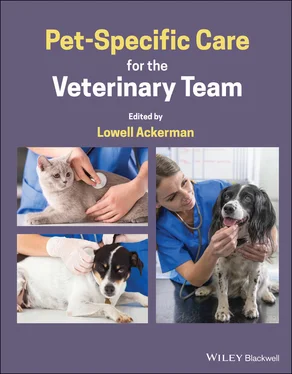In animals, almost all the DNA is compressed into the nucleus of cells, with a small amount found in mitochondria. The genetic information within an animal's genome is held within its genes and the genetic composition of a given animal for a specific variant is known as its genotype.
Genes represent a region of DNA that influence a particular phene, trait or characteristic. The dog genome consists of about 2.8 billion base pairs of nucleotides that represent about 19 000 protein‐coding genes; cats have about 2.4 billion base pairs of nucleotides that also represent about 19 000 protein‐coding genes. Humans and pets share about 85% of their genes, so it should not be surprising that many diseases found in one species may also be found in others (see 2.19One Health).
A gene is that portion of DNA that codes for a specific sequence of amino acids, which in turn make proteins, enzymes, or polypeptides. As you might expect, DNA segments resemble but are not exactly like a passenger train, with genes end to end. Leaders and trailers occur before and after genes and within the gene, and some noncoded regions called introns separate coded regions of “expressed sequences” called exons .
For any one genetic character, then, each parent contributes one version of the gene for that character, which is called an allele . The location of a gene on a chromosome is its locus .
Given four bases (G, C, A, T) that can be arranged in groups of three (codon triplets, such as ATG, the triplet codon for the amino acid methionine), there are 64 (4 3) combinations possible, but since there are only 20 amino acid products, this provides much opportunity for redundancy in the system (e.g., the amino acid alanine can be formed from the triplet codons GCT, GCC, GCA, GCG, AGA, AGG, CGT, and CGC). The average protein the DNA codes for is about 1000 amino acids long, which also means that it is about 3000 codons in length (three codons to one amino acid). Combined with codons that initiate and complete reading (for example, ATG is a start codon, and TAA, TAG and TGA are stop codons that mark the end of a sequence), the arrangement of codons is called an open reading frame .
Given an alphabet with only four letters (A, G, C, T), it may seem improbable that these nucleotides could account for all the genetic diversity in the world. Given also that these nucleotides code for only 20 amino acids, it seems difficult to forge a plausible argument for all the genetic variations seen. Because those four nucleotides can occupy any position along the DNA sequence, however, even a 10‐nucleotide stretch can form 4 10(more than 1 million) different combinations. Imagine it as a combination lock: instead of a three‐number sequence, you have an amino acid sequence of nucleotide triplets (e.g., CAT–TAG–GAC–ATT) that can code for an almost endless array of proteins.
DNA stores biological information and that information is conserved and replicated as the strands peel apart and are duplicated. Just like a photocopier, cells copy the DNA throughout an animal's life as cells are replenished and, for the most part, there are very few errors in the duplication process.
Genetic diseases usually cause problems because a mutation creates a poorly functioning facsimile of the normal gene product ( Box 3.1.1). Such a mutation often happens because of innocent‐appearing mishaps that result in an altered product.
Box 3.1.1Story of a mutation
We know that the genetic code is actually written with triplet codons, such that three nucleotide bases together code for a single amino acid. Thus, using the four bases, adenine (A), thymine (T), guanine (G), and cytosine (C), we can construct a chain of bases that code for amino acids that will form an enzyme, a protein, or a polypeptide. DNA is read three bases at a time, and these three bases correspond to specific amino acids. Accordingly, TATAGACAACAT would be read as tyrosine (TAT)–arginine (AGA)–glutamine (CAA)–histidine (CAT).
Redundancy is built into the system. For example, both TAC and TAT code for tyrosine, so if the T in position 3 happens to be replaced by the base C, the final product is not affected (a silent mutation). Now, given the previous sequence, imagine that a point mutation occurs that deletes the third base in the sequence (T). With the bases after that point shifting one to the left, the first codon becomes TAA, which is a stop codon and arrests the process. If the deletion were to occur to the fourth base (A), the resulting peptide would be changed to tyrosine (TAT)–aspartic acid (GAC)–asparagine (AAC), which is completely different from the peptide normally produced.
Even though DNA replication is remarkably efficient, mistakes occasionally do happen. A base substitution that results in a stop codon, prematurely halting the process, is called a nonsense mutation ; the resulting polypeptide will be shorter than usual and probably not functional. Progressive retinal atrophy (PRA) in the Irish setter, for example, is the result of a nonsense mutation in the cGMP‐phosphodiesterase‐beta gene. A missense mutation occurs when one base is substituted for another, which potentially results in a different amino acid occurring in the chain.
In some cases, the resultant polypeptide may not be functional. In other cases, however, because of redundancy built into the system, a base substitution will not change the amino acid product (e.g., CAT and CAC both code for histidine). This substitution is referred to as a silent mutation . Hemophilia B is characterized by a substitution of A for G at nucleotide 1477 in the gene for canine factor IX, resulting in the substitution of glutamic acid for glycine at position 379 in the factor IX molecule, which decreases the efficiency of blood clotting.
In contrast to missense mutations, in which only one amino acid in a sequence is affected, if a base is inserted or deleted in the DNA strand, it has the potential to alter the reading of the entire coded sequence downstream because the triplet codons are now out of their original sequence. This mutation is known as a frameshift mutation, an example of which is X‐linked nephritis. In simple terms, take the phrase “how are you” and insert the letter b after the letter h in how to see how a simple insertion of one base can change expression. The shift results in “hbo war eyo u” which doesn't communicate the same message as “how are you.” You can imagine what would happen to a genetic sequence in the same circumstances.
Considering that a point mutation happens by chance, that it can affect any bases in a DNA sequence for a peptide, and it then passes to future generations, it should not be surprising that similar disorders in different breeds can result from very different gene mutations. That is why the DNA test for PRA in Irish setters will not work in miniature poodles. Although the final clinical result of PRA is similar, the underlying genetic disorder could not be more different. When the incidence of mutations is combined with the fact that about 70% of all mutations are recessive, it is not difficult to see how they can be propagated.
3.1.5 Propagation of Traits
If you have a breeding animal that has superior attributes (phenes) but inadvertently carries a recessive trait that is not clinically evident even to the trained eye (genes are read in pairs, and if one of those pairs reflects a recessive trait, then the trait will not be displayed), then the pet may be bred intensively. If that recessive trait is not present in the other breeding stock, all the offspring (F1 generation) will appear clinically (phenotypically) normal, but some of the offspring will still carry that recessive trait. If that generation is bred to unrelated stock, all the next generation (F2) will also be phenotypically normal, with even a smaller percentage being carriers. If bred to related stock that also carry the mutation, however, the recessive trait will begin to be concentrated and manifested.
Читать дальше












